Expert Q&A: Bioneers Co-Founders Kenny Ausubel & Nina Simons
By Amy Nelson
Bioneers was founded by the husband and wife team of Kenny Ausubel and Nina Simons. Both social entrepreneurs and visionary thinkers, they lead the organization with passion and a powerful combination of skills as communicators, collaborators, and connectors. In 2017, Kenny and Nina were presented the Goi Peace Award for their “pioneering work to promote nature-inspired innovations for restoring the Earth and our human community.”
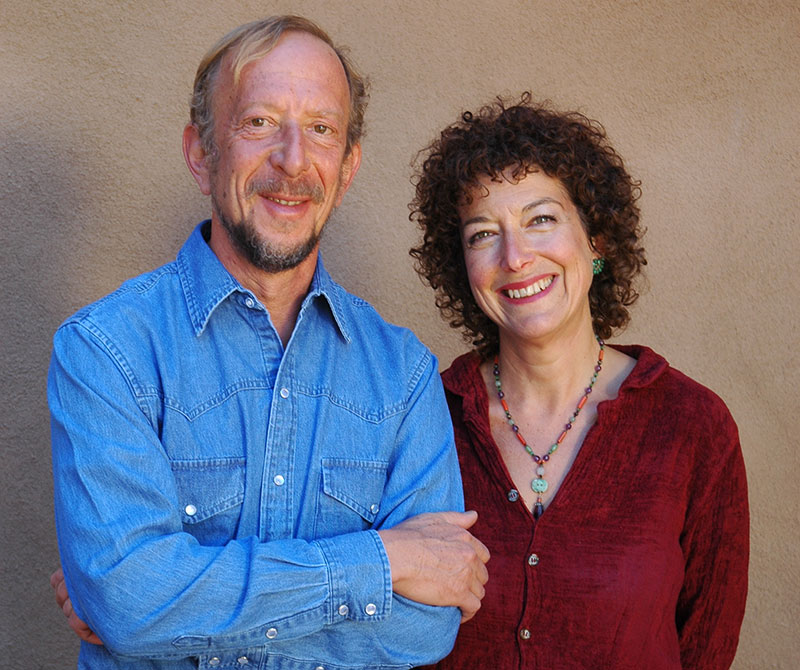
Kenny Ausubel is an author, journalist, and filmmaker. His award-winning creations include the critically acclaimed 1987 documentary film, Hoxsey: How Healing Becomes a Crime, the international radio series The Bioneers: Revolution From the Heart of Nature, and his most recent book, Dreaming the Future: Reimagining Civilization in the Age of Nature (Chelsea Green, 2012). He was a central advisor for Leonardo DiCaprio’s feature documentary, The 11th Hour, and appeared in the film. Kenny is the former CEO of the first national organic seed company, Seeds of Change, which he co-founded with Gabriel Howearth in 1989.
Nina Simons is an international public speaker who is passionate about healing our relationship with the natural world, women’s leadership, and beloved community. She co-founded and led the Cultivating Women’s Leadership program, which brought women of diverse cultures, ages and backgrounds together to learn leadership from and with each other. Known for her warm heart, Nina brings her infectious vision of reimagining how to live on Earth and with each other into organizations and training settings. Before co-founding Bioneers, she directed strategic marketing for Odwalla, and later served as marketing director and president of Seeds of Change. Nina received a Robert Rodale award in 2003. She is the editor of the anthology Moonrise: The Power of Women Leading from the Heart, and the author of the book, Nature, Culture & the Sacred: A Woman Listens for Leadership (Green Fire Press, 2019), which earned a Silver Nautilus Book Award for Social Change and Social Justice, and a Gold Nautilus Award for Women in the 21st Century.
What is the origin story for Bioneers?
Kenny: I came of age and became very involved with social movements during the 1960s. As the ’60s drew to a close, anybody who was paying attention knew that we were facing a looming environmental crisis based on the trajectory that we were on. I also had a serious health issue that turned out to be environmentally related (toxicity) so I was particularly aware of environmental health issues. I was then working as a journalist sporadically, and I wanted to know if there were people out there with genuine solutions to the environmental crisis. I began to explore, read, and learn. Over time, I met a whole string of people I came to call “Bioneers” because they were systems thinkers who were looking to nature for solutions: John Todd, Amory Lovins, Wes Jackson, Peter Warshall, Lyn Margulis… the list is long.
In 1985 I was invited to make a film about an unusual garden at San Juan Pueblo [an indigenous community near Santa Fe, New Mexico]. It was there that I met Gabriel Howearth, an organic farmer and master seed collector, and learned that it was not just seed stocks that were radically endangered, but also traditional knowledge of seeds, farming, and land management practices. In 1989, Gabriel and I cofounded Seeds of Change to restore biodiversity to the food web through gardeners. In tandem with the company, we launched our very first nonprofit project: The Native Scholars program to help conserve traditional Indigenous knowledge.
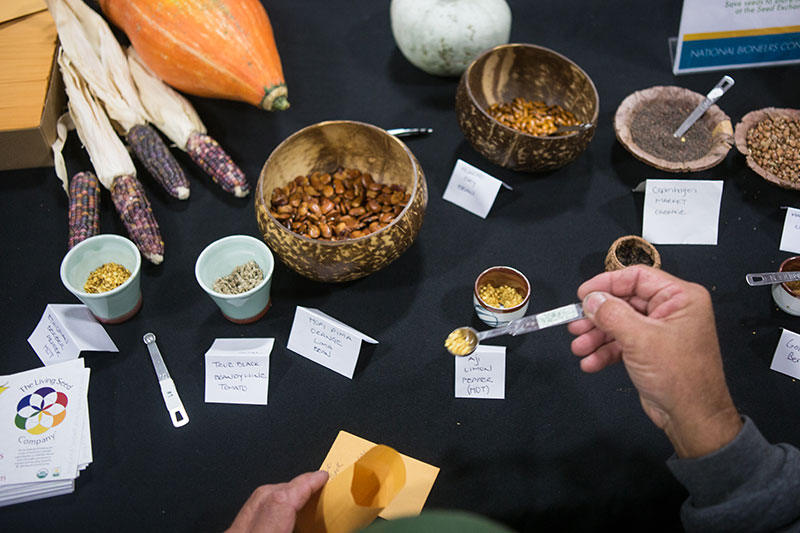
During that period, I was visiting with one of our Seeds of Change investors, Josh Mailman, and I was ranting about all these amazing people I had found who were looking to nature and taking a systems approach [to solve environmental crises]. At some point, Josh said, “Why don’t you have a conference?” I’d never been to a conference, and it sounded really boring, so I ignored the suggestion and kept talking. A few minutes later, he interrupted me in mid-sentence and said, “Kenny, I’m giving you $10,000 to have a conference.” That was how Bioneers originated.
Nina, who had worked with me on the Hoxsey film and on Seeds of Change, had a background in theater, production, and media, and she very graciously offered to co-produce the conference with me.
Nina: I brought my theater production skills as well as my executive leadership and management skills to co-create what became Bioneers. I had become fascinated with what I called “transformational theater,” the unique capacity that live theater has to bring people into an experience that causes them to really question their core values and beliefs and can actually help change hearts and minds. I, too, had never been to a conference. That quality of beginner’s mind was tremendously helpful for us because we got to design a conference that we imagined would be the most powerful, engaging, and interesting.
With so many pressing and intersecting issues, how do you plan the Bioneers conference agenda? Do you know the content of your speakers’ talks in advance?
Kenny: We have a terrific programming team with deep expertise in specific areas, and we start getting together around January. We have 13 topic areas that are consistent across time, but the temper of the times is always evolving. There’s a lot of back and forth. It’s not as if we start out with a firm plan. It’s more like jazz.
Nina: We are well aware that people often come to Bioneers with an interest in one topic area. We see part of Bioneers’ role as helping to expand people’s understanding of the interrelatedness of all the issues that we face. We also seek to be multicultural, multigenerational, and across class, and to present a wholeness for each session while also feeding people’s particular interests. We think of the conference’s three days of keynote talks as being like a symphony. The Friday keynote opens the symphony, and then there are recurrent themes that resonate through the course of the weekend. Each day stands on its own, but to get the whole symphony you need to experience all three days. We select our speakers for their body of work and because we know they’re likely to give a talk that will move people’s hearts and minds, but we don’t know in advance what people will talk about.
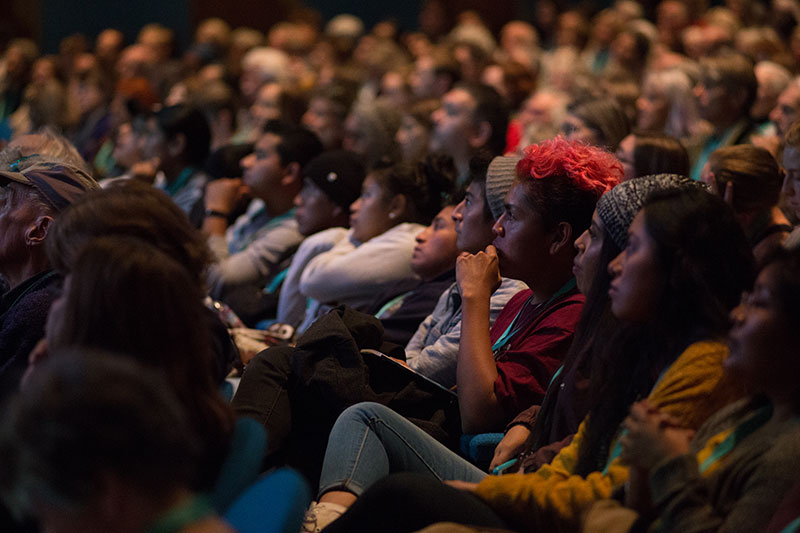
We have changed the program over time according to people’s feedback. For instance, when we started, we didn’t have a youth program. The youth program was born in the early 2000s, after Julia Butterfly Hill said, “there aren’t enough young people here.” We’ve had feedback over the years from people who’ve asked for more interactive or experiential workshops, and we’ve added those. We’ve had feedback over time where often people come to me at Bioneers and they say, “for the first time in my life I feel like I’ve found my tribe.” We are working continually to set up ways for people to find and interact with each other, as well as hear innovative, mind-and-heart-opening ideas from experts in the field.
Kenny: We don’t micromanage or direct our speakers. Oftentimes, what will happen is someone will come up with an idea or direction that we never would have imagined. We have tremendous confidence in the speakers to say what is most important for them.
Nina: For example, this year we invited Eve Ensler. Knowing that her recently published book is called The Apology, we anticipated that she would be speaking about The Apology. What we didn’t anticipate was that because she knows Bioneers, she chose to write an apology to the earth. It was so powerful and so perfectly in sync with the message of the day.
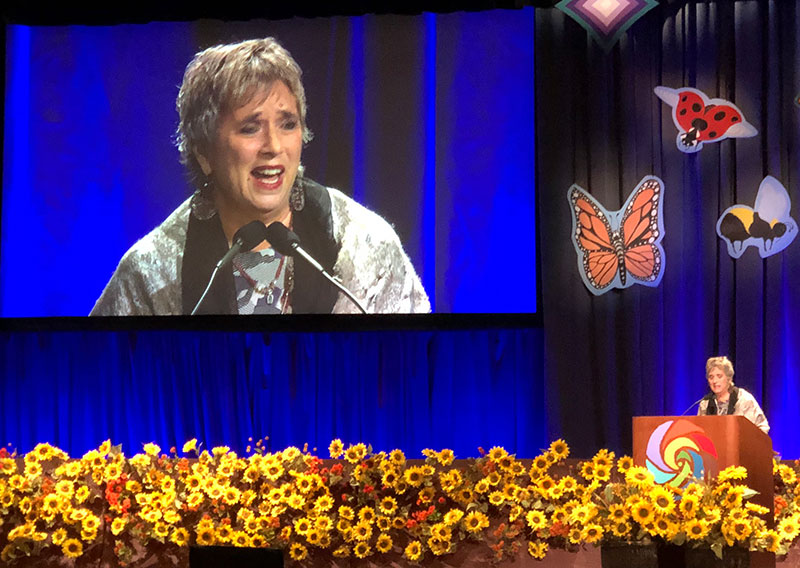
Are there any other pressing or emerging issues that didn’t make it on the agenda this year that you would love to incorporate in next year’s conference?
Kenny: There are elements that we’re going to be looking at in increasingly pragmatic ways. What was very clear this year is that there has been what Robert Jay Lifton calls a Climate Swerve, a mass awakening. It’s suddenly here and now. Moving forward, we will look at how to translate the Green New Deal into something highly pragmatic that addresses the politics as well as the ecology. At the core of the problem, the rhinoceros in the room is corporate power. There’s not even the pretense anymore of disguising state capture in what amounts to a corporate state. It’s full-on plutocratic siege, including obviously the petrochemical industrial complex and countless corporations hell bent on removing even the thin layer of environmental protections of the regulatory state.
What would it look like to design a nature-based civilization?
The second part is the ecology and the natural systems piece of it. So much of that starts with design. What would it look like to design a nature-based civilization? How can we bring forth more nature-based design elements in highly practical ways? Around 2006, we really started pushing resilience thinking and recognizing that we’re in for massive changes to which we’ll have to adapt. It’s going to require rapid adaptive management going forward, and that has got to come from the ground up. Increasingly, communities are going to be driven to rely on themselves to solve these problems. We will be increasingly highlighting the highly pragmatic efforts of communities to approach ecological and social resilience from the ground up. These are areas that we’re going to translate into really pragmatic initiatives and elevate the models that are succeeding in order to scale and spread them.
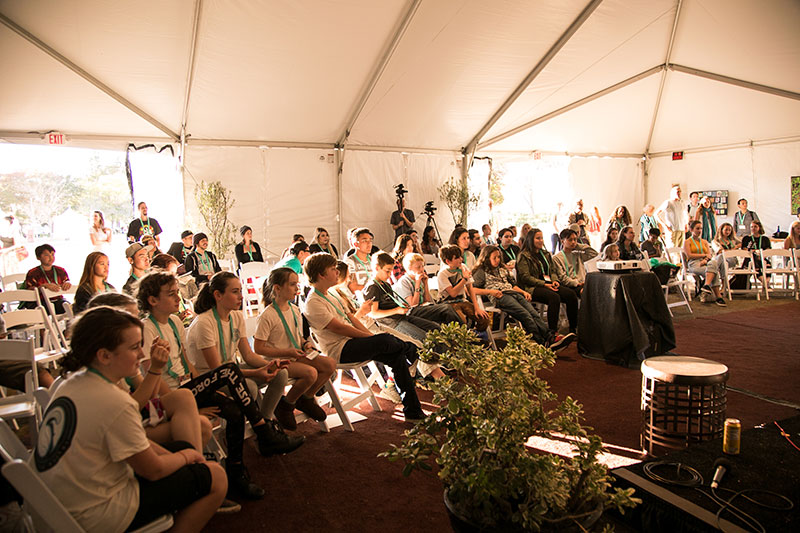
There are also three specific areas of ongoing primary importance for us: Leadership of women, leadership of young people, and leadership of First Peoples, who also happen to hold 80% of the world’s remaining biodiversity on their lands. The original Bioneers are native peoples, and from the very beginning, Bioneers’ philosophy and worldview have been deeply guided by Indigenous worldviews.
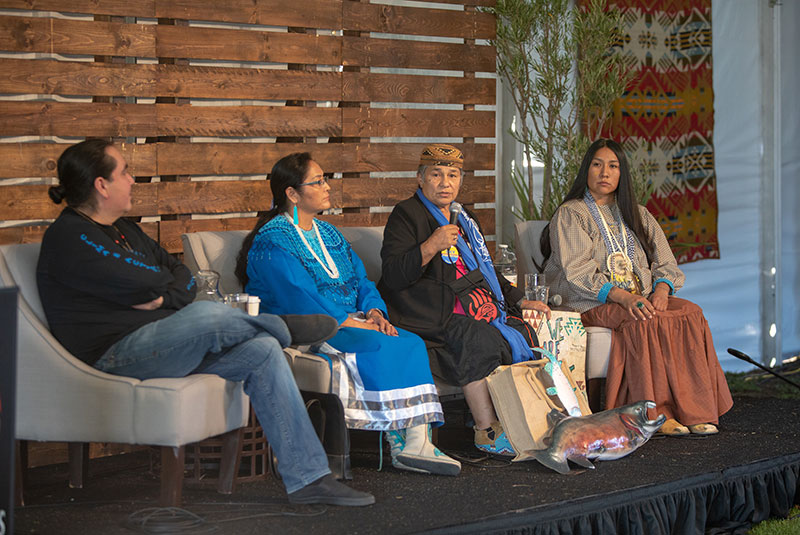
Nina: We are acutely aware of and monitoring events as they’re unfolding in real time. Next year, the Bioneers conference will be just a few weeks before the election. Whatever happens in the time in between, we know that we are in a process of learning to navigate the social divides that have been so successfully exploited by the GOP and the Trump presidency. One of the core tenets of Bioneers is the interdependence between our social and ecological health and resilience. We see Bioneers as a constellation of movements. I see movements gathering strength and momentum but what’s lacking tends to be the connective tissue that allows them to collaborate as one unifying movement. One of the unique qualities about Bioneers is that it brings together people from many different disciplines and perspectives. It doesn’t ask people to leave their viewpoints behind, but it offers a unifying field that can help people understand how to focus on our common ground, and how to collaborate across differences, which I think is one of the most important challenges we face.
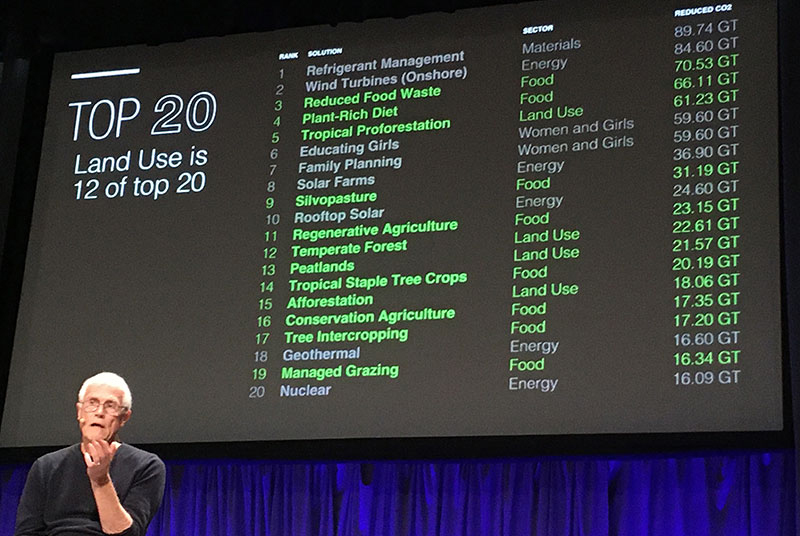
Kenny: It’s very unusual to have this convergence of movements and very different constituencies in one room, from the grassroots to the canopy. Having that unifying field is enormously powerful when you visibly see and feel how it’s all connected. At the core of everything we do is a message of healing. If you study nature, what you discover very quickly is, as Paul Hawken has pointed out, sustainability is simply the mid-point between the endless cycles of creation and destruction. We have tipped the scales so far to the destruction side that we need to put our fist on the side of restoration and regeneration. Nature has an extraordinary capacity for healing and regeneration. It’s what it does. It’s a powerful, powerful force. That’s what we need to tap, both from nature and in the human spirit.
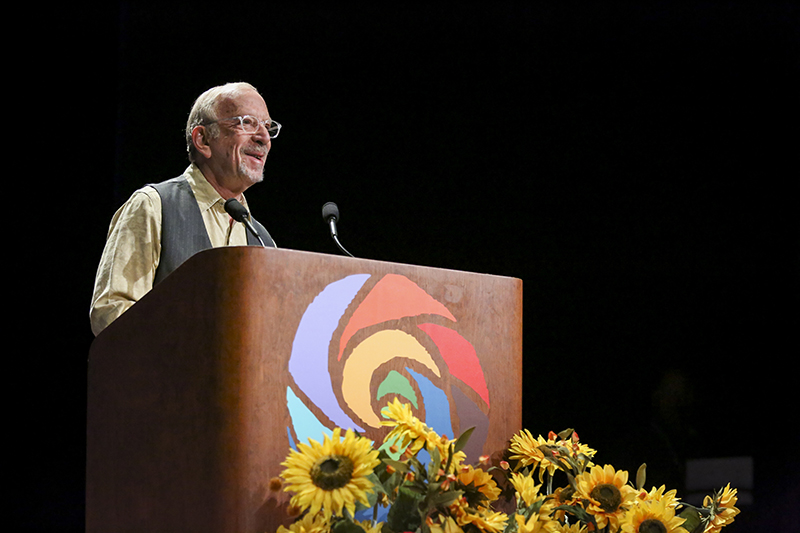
Nina: In most conferences, it is inherently assumed that knowledge is communicated through the mind. Part of Bioneers’ uniqueness is that we designed it as a way of transmitting information that is not only mental, but integrates the wisdom of the heart, body, and spirit. We do that in a very respectful way. Science is increasingly proving that the heart is actually more the governing body of our systems than the mind. Many indigenous people say that the longest distance we have to travel is to shift our leadership from the head to the heart.
Many Bioneers speakers are busy, highly sought-after people. Why do you think they say yes when they’re approached about coming to Bioneers?
Nina: What comes to my mind is that beautiful principle that Wendell Berry wrote about called Solving for Pattern. I think as speakers, what draws them is that we offer a combination of elements not common to most conference experiences, including access to a community of peers that I think they’re excited to engage with. They know that we’re attracting people who really care and are very likely to do something rather than just be spectators. They also know that the quality of our production is high in terms of the media that we produce from their talks. Part of the benefit to them is that they get a video or a podcast that they can use in promoting their own work. There is a purity of intent that we have managed to sustain with Bioneers. We’ve been very careful to protect ourselves against the corruption that sometimes comes with corporate sponsorships or other financial incentives. I think some people who are renowned and sought-after come to Bioneers for those reasons.
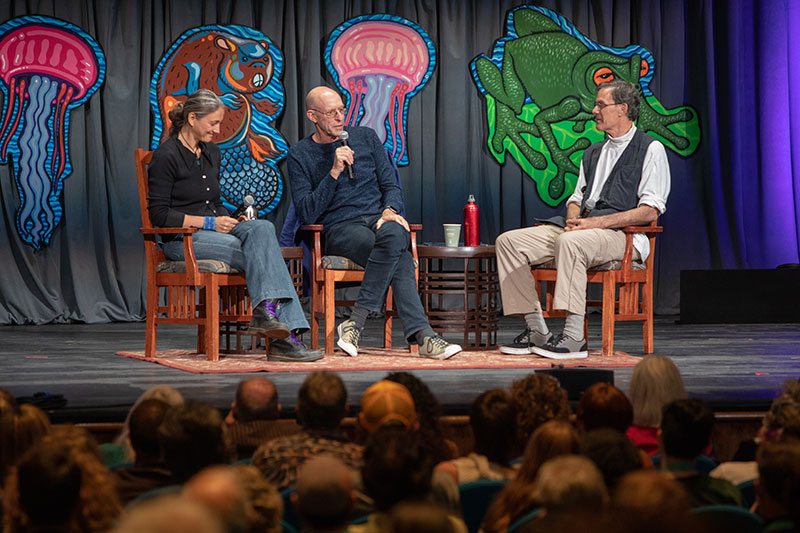
Bioneers is also a place to hear the greatest people you’ve never heard of. We are constantly doing a kind of ecological and social star search through the year to identify great innovations we think have traction and are practicable for this time.
Many speakers tell us that they give the best talks of their lives at Bioneers.
Kenny: We launched the Bioneers conference in 1990 with a clear vision of pulling together social and scientific innovators with real solutions who had looked to nature for guidance and who were systems thinkers. It was founded in the clear idea that “it’s all connected,” and that natural and human systems are one system requiring a “solve-the-whole-problem” approach. The program included a broad diversity of issues, disciplines, cultures, and walks of life, with especially strong focus on biodiversity, bioremediation, biomimicry, Indigenous science, eco-farming, and progressive political approaches that address the most basic question of democracy: “Who’s in charge?”
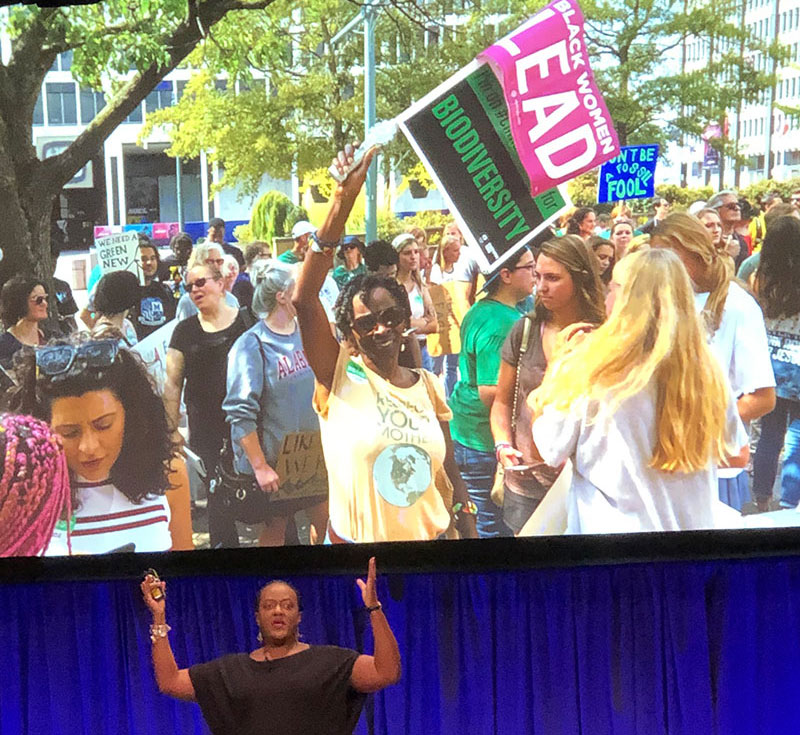
I had never been to a conference, so I designed something that was interesting to me. In the first conference, there were 250 people, which seemed huge at that time. It was much bigger than we expected. It turned into something like a revival meeting. People were so grateful to find each other and to learn about all this other breakthrough work. We had these people working across disparate fields that were otherwise siloed, who seldom had contact with people doing parallel work from a similar point of view, but in other disciplines or fields of endeavor. We have decades long relationships with people like Paul Hawken or Bill McKibben, and I think they continue to come because this is a community of activists who run with what they learn there. At the end of the day, people make amazing connections and get new ideas that inform their work. A lot of initiatives and collaborations are born from all this fertility and cross-pollination.
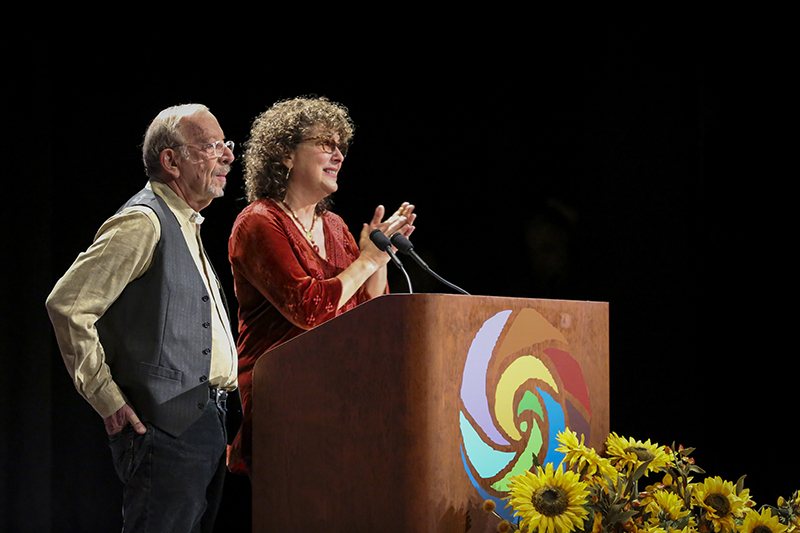
It is also medicine for the soul. A lot of people tell us it’s their annual oasis where they come to renew, regenerate, refresh and recharge their batteries for the hard year ahead that we’re all going to be facing. Many speakers tell us that they give the best talks of their lives at Bioneers. That is because of the audience. People are just right there for every word and every feeling, and it is overall a sophisticated group. There’s a real sense of communion that can only happen because of the quality, attention, and intelligence of the people there. It is a co-creative field, ultimately. Our job on the Friday morning is to create that field so that everybody fully engages. Once the field is up and running, it has a life of its own. That’s how the magic happens.
Who is not in that co-field that you wish would be?
Kenny: Part of what was very powerful to me this year was the new face of the movement, which is highly diverse. I think it has been overstated for many decades how white the environmental movement is. That certainly was true at the beginning, but it has really evolved. I think we could have an even more diverse audience if not for these physical and cultural barriers related to the site itself. The Marin Center is a beautiful space, that’s actually big enough for 4,500 people, but there is a cultural barrier between Marin and the East Bay—and there are public transportation issues. Beyond those very real barriers, we’ve been steadily cultivating more and more public servants to get involved. We have a lot of entrepreneurs and social entrepreneurs, but the business community is still pretty much lagging. It would be good for more of them to have this experience.
Nina: In studying our own demographics, we’re finding that the youth program has become very successful and is currently comprising about 20% of our audience. We would love to attract more mid-career professionals in addition to policymakers and green innovators in the corporate sphere.
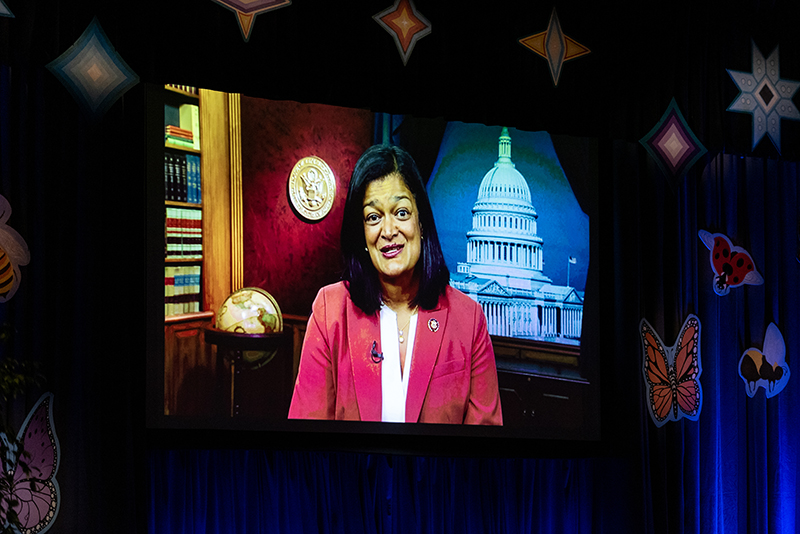
Kenny: You never know who people are going to become. At any given year, at least half the people are new. This year 60% [of Bioneers attendees were there for the first time] which is an interesting sign of the times and the awakening that’s surging. For example, we knew Congresswoman Pramila Jayapal had spoken at Bioneers years ago when she was an activist, and now she’s in the halls of Congress. She sent us a video to show on the main stage this year. Years ago, a young guy named Gregor Robertson came to Bioneers when he was running a juice company in British Columbia. As he later told us, that inspired him to go into politics. He became the mayor of Vancouver, which became the greenest city in North America with his leadership. There is a process of “becoming” at Bioneers. You may come to Bioneers because you’re interested in food systems, and suddenly, you realize how closely tied that is to social justice. Before you know it, you’ve entered into your life’s work on something you probably never thought of because you discovered it’s all connected. Bioneers is sort of a gateway drug.
There is a process of “becoming” at Bioneers.
Bioneers is often described as “transformative.” Has Bioneers transformed each of you? If so, how?
Nina: Bioneers has been the most extraordinary graduate school for me. I came into Bioneers feeling called to spread the voices and visions of the people on stage. But because of my work with Bioneers, I began being acknowledged for my leadership. I realized that I had a very mixed reaction to that. Some part of me was flattered, but a larger part of me wanted to deflect that label and didn’t feel like I had earned it. So I began a whole inquiry about leadership, and Bioneers informed that inquiry. Through the course of Bioneers, I became increasingly convinced that much of what was not working in the world could be seen as an imbalance between ‘masculine’ and ‘feminine’ in our society. That includes the archetypal masculine and feminine in our businesses, policies, and institutions, as well as the imbalance of gender equity in our culture. That really led me to a focus on women’s leadership and re-imagining leadership. I wound up publishing a book called Moonrise: The Power of Women Leading from the Heart, which described how I believe we’re all reinventing leadership in this time and explained for myself what that antipathy that I had previously felt was.
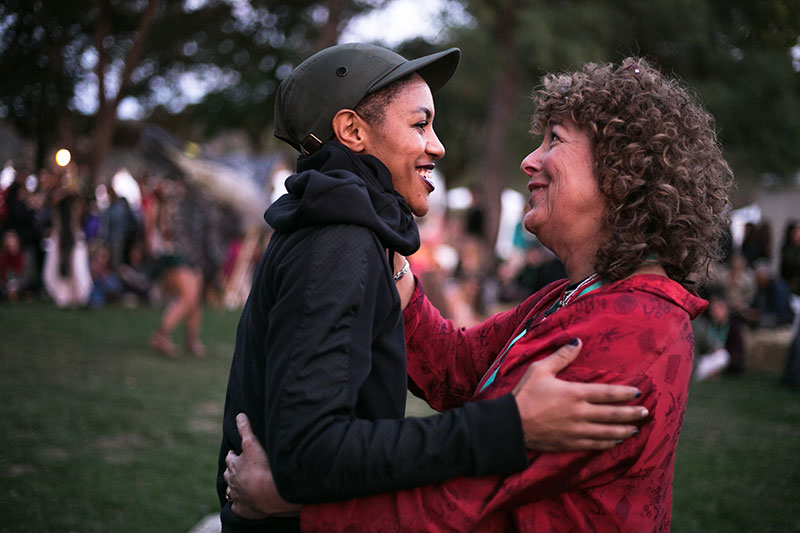
Bioneers has affected me in myriad ways. Perhaps the most profound of which is that I see the world–including the social world–through a lens of natural systems. This causes me to have a different worldview that is informed deeply by both natural systems and indigenous traditional worldviews, all of which I feel incredibly thankful for because it feels like it’s preparing me for a very tumultuous time ahead in really good ways.
Kenny, what about you?
Kenny: I think one of the other uniqueness of Bioneers is the way it brings together the inner and the outer–the heart, the body, and the spirit, as well as the mind. We like to say that the reason some of the magic happens at Bioneers is that people are firing on all seven chakras. That has been transformative for me. As you know, the odds we face are very long. It is daunting, and it’s easy to get discouraged and feel isolated. But having that sense of how many of us are out there all day, every day, waking up, doing this work, and making change—hearing story after story about what Bioneers has meant to people and how it has influenced their life and work. That has been really transformative for me: feeling that expanded sense of community and seeing it grow so radically over these decades. We can’t even keep up with the avalanche of great work going on these days, largely driven by civil society.
Nina: Bioneers has really cultivated my taste for valuing diversity in any living system. That has been true not only in terms of deepening my commitment and understanding about racial and gender justice, but also about ageism, classism, and all the ways that our society tends to pigeonhole and segregate elements of our humanity. That has been a tremendous gift. I don’t consider any person fully integrated unless I can sense the integration of their body, heart, mind and spirit. I think that, that’s partly a product of my learning through Bioneers.
Nina, in your book Nature, Culture and the Sacred: A Woman Listens for Leadership, you discuss the need for us to cultivate conscious kinship. Practically speaking, how do we begin to do that?
Nina: I’m speaking not only about conscious kinship with ourselves and each other as humans, but also with the whole of the natural world. In many ways, I am profoundly inspired by the work of Robin Wall Kimmerer who wrote Braiding Sweetgrass and many indigenous teachers, who teach consistently in their traditional wisdom that you don’t harvest a plant without praying to it, without asking its permission, without saying its name and giving it an offering. There is a principle of respectful reciprocity that is embodied in that practice. That also holds true for how we can cultivate respectful kinship with people who are different than us.
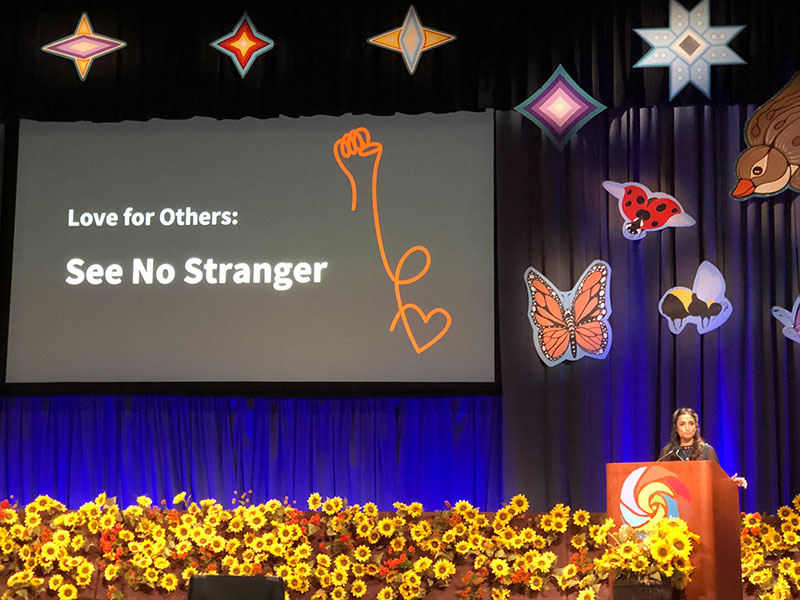
We have such a tendency toward defensiveness or digging in our heels or feeling self-righteous. In the work I’ve done with racial justice, I’ve learned that this may be part of the legacy of a culture of white supremacy. When faced with the pain or anger from a person-of-color expressing what they have experienced through the bias of our culture, we get defensive rather than allowing ourselves to feel, empathically, what they have been feeling and therefore be willing to let our hearts experience the injustice of what we’re complicit in. My primary advice would be to lead from our body and heart’s wisdom–rather than our heads–and meet people where they are rather than assuming that we know what’s right.
Kenny: A lot of it involves just plain listening.
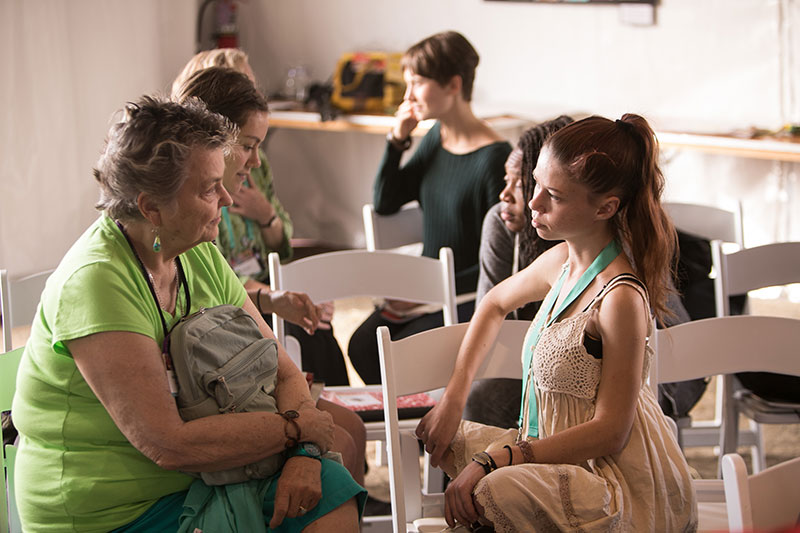
Nina: There is a practice of deep listening that really involves not rehearsing, not responding, not anticipating what you’re going to say next, but really being present to somebody else’s experience in a way that our culture doesn’t teach us so well how to do. Operating from the presumption that their experience might be equally valid to our own creates a basis for common ground. The ecological and social challenges that we face ahead are going to require us to form what are sometimes called “nightmare coalitions.” We will need to collaborate with people who we may not necessarily agree with, but for the sake of our survival and health, we need to find the common ground and be able to meet there.
Leadership at this time requires us to be in a real dance of listening over speaking, practicing humility, and actively cultivating our collaboration skills…
You are both leaders, and through Bioneers you have interacted with so many other leaders. What leadership qualities do you think are most needed in advancing this movement of movements to address climate change and the many social challenges with which it’s intertwined?
Nina: Leadership at this time requires us to be in a real dance of listening over speaking, practicing humility, and actively cultivating our collaboration skills–particularly around navigating ruptures. Our society has not taught much that’s useful about how to navigate what to do when ruptures happen. We’ve all experienced fights or disagreements, whether it’s with our family, partner, or work colleagues. Instead of turning away, we need to cultivate our capacity to turn towards those ruptures when they happen. I believe that the endurability and flexibility of every relationship is a function of how well we navigate repairs.

Kenny: I’m working on an independent film project called Changing of the Gods: Planetary and Human Revolutions. It’s a 10-part series that looks at the cycles of revolution and large-scale social transformation across history through the lens of consciousness. One of its themes is the idea that worldviews create worlds. We are in a time of a very radically shifting worldview. I think we’re moving beyond just this idea that there is intelligence in nature. Now scientists are asking, “Is there anything that isn’t intelligent?” There is a deeper mystery, which is the mystery of consciousness itself. It is increasingly appearing likely that consciousness and sentience pervade all of nature and potentially the cosmos itself. When you begin to entertain that kind of worldview–that we’re part of one unbroken, infinitely interconnected wholeness that is much, much larger than ourselves–everything changes. I think that is part of what Nina is referring to in relation to humility.
For me, part of humility is having a sense of humor. I am so not interested in a leader that doesn’t have a sense of humor at the fullness of human folly. The people that I really resonate with are authentic. They’re really being who they are and telling what they really think. They do it with joy. They do it with fierce honesty. They do it with laughter.
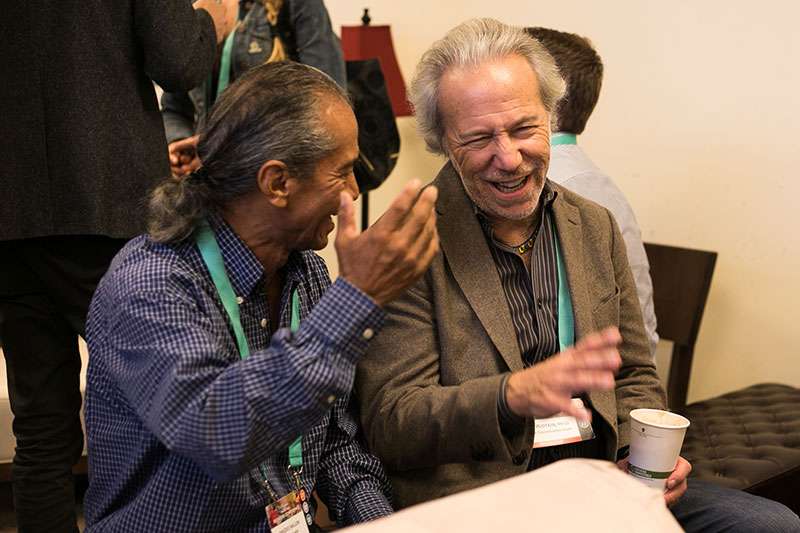
You’ve amassed 30 years of Bioneers wisdom. If you could give Leaf Litter readers a directive based on that wisdom, what would it be?
Nina: I’d offer them a deep bow of gratitude, because they probably don’t get appreciated enough. Your readers are system thinkers, and what they are bringing into the engineering and design world is a consciousness–not only of our relationship with the natural world, but of how design and the built environment affect our relationships with each other and with ourselves. I encourage your readers to go online to experience what Bioneers offers. It is a whole system approach that I don’t see happening anywhere else in quite the same way. Whether we are educators, in governance, or designing for public spaces, we would all benefit from the influence of traditional ecological knowledge and traditional wisdom cultures.
We are in a pivotal moment for evolving and transcending a culture of white supremacy that we have inherited. My work with multicultural peoples has led me to understand that we would be so wise to get humble and discover what there is to learn from communities of color that, in order to adapt to a society that privileges white people, we have lost. We have developed blinders around our eyes and shells around our hearts. The combination of capitalism and patriarchy has led us to a place where we even unconsciously create hierarchy and imagine that we may know more. That is a very dangerous assumption at this moment.
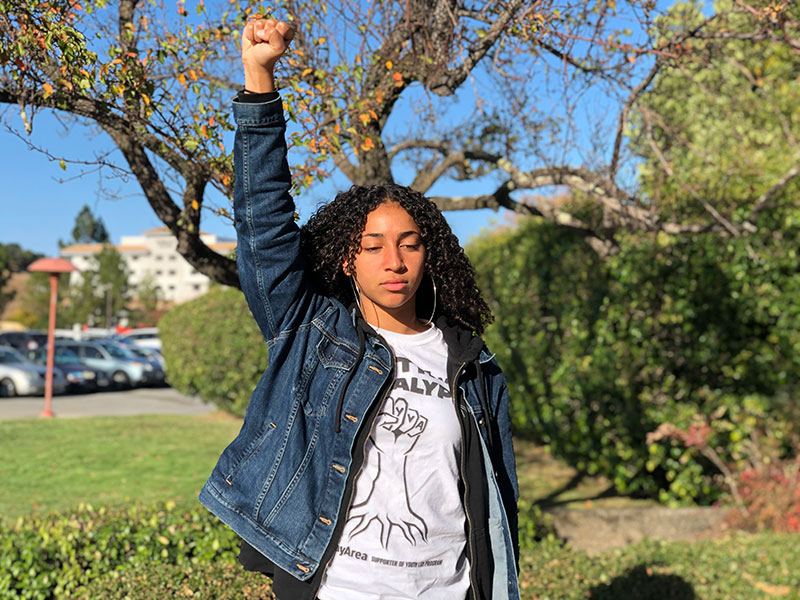
We are being given role models, in the form of some of the leaders of Black Lives Matter and immigrants’ rights movements and in the indigenous and young people rising up around the world with an urgency and a clarity of focus about climate justice that we would all do well to pay greater heed do. Beyond that, we’d all do well to light a fire under our own butts and challenge ourselves to do more.
When we started Bioneers, we used to say that the reason climate justice was increasingly imperative was for our children and our children’s children. It’s now. We are in it. There is no time to keep putting it off. We need to hold ourselves and each other accountable for really courageous and strategic action right now and for pushing the limits of where we imagine we have the capacity to go, because all of life depends on it.
